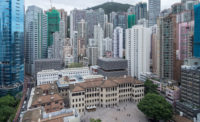Tours, France
In Tours, France, a building-size mask has transformed the nondescript face of an experimental arts center into a striking neighborhood talking point. Built from clear Plexiglas and lit by LEDs, the work—by Paris-based PCA Architecture—conceals the drab exterior of the Centre de Création Contemporaine (CCC) in a curvaceous display of lines of white light and repeated reflections.
Along with a number of stores, the CCC occupies part of the first floor of a residential tower for the elderly. “This building,” says CCC director Alain Julien-Laferrière, “is of no architectural interest. It’s made of concrete; it’s ugly.” Julien-Laferrière’s team decided against restoring the neglected exterior, instead selecting an architect who could show “the creation and the life inside the center, and to communicate that with the exterior,” he says.
In 2003, the CCC launched a competition for “a concept for a new facade expressing contemporary art,” says PCA founder Philippe Chiambaretta. After his studio won, it took another three years for the center to raise the 180,000 euros ($284,000) to construct the project.
Smooth and blobby, Chiambaretta’s winning proposal gave the CCC facade the appearance of green Jell-O stuck to the existing building’s front—a glowing skin that evoked a cell deformed by molecules passing through it. “The project was a tridimensional envelope shaped by the flows of information,” Chiambaretta says of the form, which he describes as allowing visual cues to pass between occupants, artwork, and passersby. For six months, PCA worked with engineering firm RFR to turn the concept into a buildable structure, but it was “very difficult to maintain the lightness of the initial idea due to the technical and financial constraints,” he explains.
The designers call the final work 19h04 to honor the time, 7:04 in the evening, when they first switched it on. The project represents “low consumption, low cost, and long life cycle,” an approach that Chiambaretta says he takes with all his lighting designs. The 82.4-foot-long 19h04 comprises 150 12.1-foot-high Plexiglas profiles spaced 9 inches apart, enough to maintain visual cohesion while providing space for maintenance. Slotted metal brackets hold the 1¼2-inch-thick Plexiglas planks upright and in place. White LEDs are glued with silicon to the back edge of each plastic sheet.
To make a backdrop that contrasts with the project’s 150 glowing slivers, Chiambaretta placed a dark, translucent film over the existing building’s windows and painted the original elevation black. “We considered the possibility of using many colors and a sophisticated program to control them,” he says, “but I decided to stay simple, with white on a black wall. It’s a black-and-white project.” Light passing through the plastic creates sensuous, curved, white lines, then slowly dims and brightens in tailor-made patterns to create a dynamic surface. Of the programmable dimmers, Chiambaretta explains, “For exhibitions organized by the CCC and openings, we go from very strong light to moderate. When the light is on 100 percent, it is incredibly clear, almost like daylight. And during the evening, when everybody goes out to smoke, we bring the level down.”
Compared to PCA’s larger built works, such as the Pinchuk Arts Center in Kiev, or competition entries such as the Tour Signal at La Défense outside Paris, the CCC facade is more experimental in nature. “We think a lot in these small and long-lasting projects, then they infiltrate the more applied projects,” Chiambaretta says. 19h04 may inspire out-of-the-box thinking among users, too. As the architect posits, “This street is quite empty at night, but the lighting creates a sense of safety as well an oddity that attracts people who are curious about how the project works. They look closely, and then they want to learn about the exhibition inside.”


Post a comment to this article
Report Abusive Comment